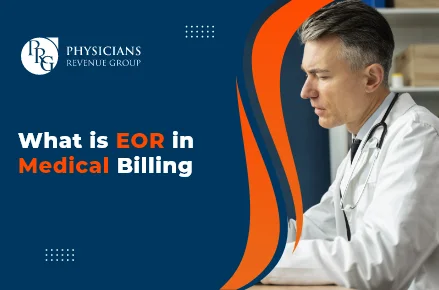
Email: info@prgmd.com | Call: +1 (630) 242-6474
Business hours: 9:00 to 5:00 | Monday to Friday
Email: info@prgmd.com | Call: +1 (630) 242-6474
Business hours: 9:00 to 5:00 | Monday to Friday

Table of Contents
ToggleImproving healthcare practice cash flow involves incorporating effective strategies for revenue cycle optimization. The optimization of revenue cycle management involves analyzing and then improving the financial processes of a healthcare practice. To understand RCM further, consider it a process that manages financial transactions between a healthcare organization, its patients, and payers. Healthcare revenue cycle optimization is the process that improves the efficiency and effectiveness of a healthcare practice’s finances.
RCM is a complex process involving multiple steps, including patient registration, insurance verification, claims submissions, charge capture, healthcare financial analysis, payment posting, AR, and denial management. Each step calls for effective strategies for revenue cycle optimization – and must be carefully managed to ensure that your practices receive accurate and timely payments.
Numerous elements contribute to a healthcare organization’s healthy revenue cycle. At the forefront, patient billing and cost communication are two important effective strategies for revenue cycle optimization. Both of these help determine how quickly and willingly patients can pay. Recognizing that non-payments and payment delays can risk your healthcare practice’s viability is essential.
Now, at the backend, healthcare providers must manage contracts and claims with the insurance companies – all the while targeting timely payments, no underpayments, and minimal to no denials. These roadblocks add to the practices’ financial load and burden patients.
Healthcare professionals must do all this to improve the revenue cycle – all in an economy that heavily burdens patients and their budgets. Therefore, new and effective strategies for revenue cycle optimization are necessary to keep up with the changing circumstances. Furthermore, such strategies can help providers remain fiscally healthy while offering top-level care.
Let’s discuss some of the effective strategies for revenue cycle optimization:
One of the first effective strategies for revenue cycle optimization is making sure that you are getting enough patients through your doors. In-depth, there are two sides to this equation, which include:
Collectively, both of these play an essential part in improving your healthcare practice’s revenue.
This step goes hand-in-hand with the patient eligibility verification process. When a patient makes an appointment with your practice, your staff must collect their up-to-date information, including:
Note: if a patient self-schedules an appointment through your portal – they must be able to enter this data as a part of the overall process.
Moreover, offering patients the option to make online payments is a good way for practices to ensure and encourage timely payments. Online payments are both familiar to patients and convenient. Ideally, the more simple and accessible your payment processes are, the better your patients will respond.
Claim scrubbing is next on the list of effective strategies for revenue cycle optimization. It is a process of ensuring correctness, accuracy, and completion before submitting claims to insurance providers. Furthermore, it is an ideal and easy way to improve the chances of prompt payments, yet another task that can be automated.
Modern tools have made the claims scrubbing process instantaneous instead of a lengthy and manual undertaking.
Using the latest technology is essential to ensure that billers and the administrative staff correctly code and meet the insurance providers’ requirements. Technology utilization is one of many important and effective strategies for revenue cycle optimization. Incorporating the latest IT solutions can help your claims submission processes by minimizing delays and errors.
When machine learning and AI are incorporated into healthcare financial management – they can simplify your end-to-end back-office RCM processes. Technology utilization can also help reduce time, effort, and money spent on coding, billing, and eligibility authorization practices.
In healthcare, claim denials are inevitable – however, these can be minimized with attention to detail and careful planning. For instance, outsourcing your healthcare RCM to third-party experts can yield a 99% first-pass acceptance rate. Without a doubt, this is an outstanding benchmark to aim for, regardless of how you choose to manage your RCM practice.
The effective strategies for revenue cycle optimization also include following up on the denied claims. Many claim denials are lost in the process and are never resubmitted – which means a loss of revenue to healthcare practices. Processes that automatically pinpoint denied claims for reviews and resubmissions can help ensure that your practice RCM isn’t under severe disruptions.
Moving further along the effective strategies for revenue cycle optimization, we have staff training. Mostly, the front-end tasks fall on to the administrative staff, while varying back-office teams/departments work on the backend activities, including claim submissions, edits, and resubmissions.
But, when you train your staff on the comprehensive RCM workflow – everyone will be able to understand the whole revenue cycle much better. Your administrative staff can collaborate closely with the back office to improve the RCM process and maintain a steady cash flow.
Claim denials are one of many things to follow up or focus on. It is important to have a working plan to contact patients who are not paying timely. Furthermore, have a script for your staff to follow up on such instances and contact payment-delinquent patients.
Effective strategies for revenue cycle optimization here suggest presenting patients with multiple options. Ask them if they would prefer to set up a payment plan, pay off things in full, or even if they want to come up with another solution themselves. Affording such flexibility to your patients will help maximize the revenue you can collect from such situations.
Many patients find the billing process overwhelming, and thus, your staff must have the training to offer verbal and written explanations to patients. These explanations include information regarding the following:
Moreover, you can speed up the claims submission process and reimbursements by communicating all such requirements to patients. Additionally, when billing and administrative staff have ample training, they can exercise overall control over their actions. Further, they can help boost patient satisfaction levels and promote positive patient-provider relationships.
One of the most effective strategies for revenue cycle optimization is outsourcing your billing operations to a third-party billing provider. By entrusting your RCM processes to experts, you can improve your medical billing practices massively. Outsourcing is also how many healthcare organizations are improving their RCM. Partnering with third-party billing companies is efficient and easy and works to remove the burdens of revenue optimizations from your plate.
When you outsource, your revenue cycle manager will seek ways to improve the process efficiency to capture more charges and get faster payments.
Share:
Categories
Recently Added

What is an ABN in medical billing?

What does a Clearinghouse do During Claims Submission?

What is EOR in Medical Billing?
We Would Love to Assist You!
We treat your data confidentially and don’t share any information with a third party.